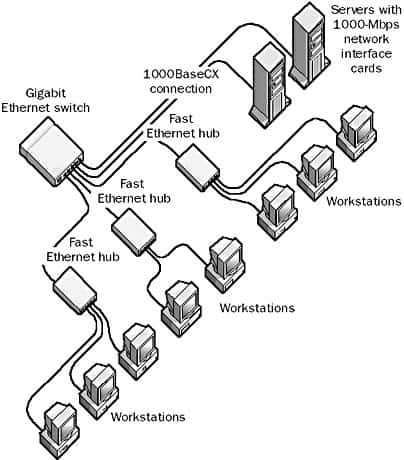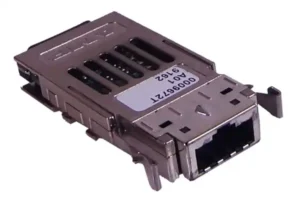The 1000BaseCX standard is an integral part of the Gigabit Ethernet family, defined within the 802.3z standards of Project 802 by the IEEE. Designed for high-speed data transmission, 1000BaseCX is tailored for short-distance communication over copper cabling.
This article provides a comprehensive look at 1000BaseCX, covering its technical specifications, applications, advantages, and considerations for implementation in contemporary networking environments.
In this article:
- What is 1000BaseCX?
- Historical Development of 1000BaseCX
- 1000BaseCX vs. Other Gigabit Standards
- Implementing 1000BaseCX
- Applications of 1000BaseCX
- Troubleshooting and Maintenance
- Future of Copper-Based Ethernet
- Conclusion
- References

1. What is 1000BaseCX?
1000BaseCX is one of the standards set for Gigabit Ethernet over copper cabling. It’s designed to operate over short distances, typically up to 25 meters, using shielded twisted pair (STP) cables. The ‘1000’ in the name signifies the maximum data transfer rate of 1000 Mbps, while ‘Base’ refers to baseband signaling, and ‘CX’ indicates the use of copper cabling (short-haul copper). Gigabit Ethernet standards are defined in the 802.3z standards of Project 802 developed by the IEEE.
Technical Specifications
- Speed: 1000 Mbps
- Maximum Distance: 25 meters
- Cable Type: Shielded Twisted Pair (STP)
- Connector Type: 9-pin D-sub
- Encoding Method: 8B10B
Design and Operational Principles
1000BaseCX employs the 8B10B encoding method, which ensures signal integrity and supports the high-speed data transfer inherent to Gigabit Ethernet. It uses a point-to-point configuration, commonly connecting switches to routers or servers where high bandwidth and low latency are required over short distances.
2. Historical Development of 1000BaseCX
The Inception of 1000BaseCX in the IEEE 802.3z Standard
1000BaseCX was introduced as an integral part of the IEEE 802.3z standard, which was ratified in 1998. This standard represented the first generation of Gigabit Ethernet over copper. The ‘CX’ variant was specifically designed to meet the high-speed data requirements over short distances, using shielded twisted pair (STP) cables.
Evolution within the Gigabit Ethernet Family
- Over the years, 1000BaseCX became a building block in the Gigabit Ethernet family, particularly valued for its ability to provide reliable connectivity in environments with high electromagnetic interference (EMI).
- As technology advanced, other standards in the Gigabit family, such as 1000BaseT and 1000BaseSX, started to gain popularity due to their longer cabling distance and the growing ubiquity of UTP and fiber optic cables.
- Despite the advent of these newer technologies, 1000BaseCX maintained its relevance in specific scenarios requiring robust short-distance communication, especially in industrial settings and data centers.
3. 1000BaseCX vs. Other Gigabit Standards
In the landscape of Gigabit Ethernet, 1000BaseCX is one member of a broader family of standards, each tailored to specific network requirements and environments.
1000BaseCX vs. 1000BaseT:
- Cable Type: While 1000BaseCX utilizes shielded twisted pair (STP) cables, 1000BaseT can operate over unshielded twisted pair (UTP) cables.
- Distance: 1000BaseT supports longer cable lengths, up to 100 meters, compared to 1000BaseCX’s maximum of 25 meters.
- Deployment: 1000BaseT is widely deployed in a variety of settings due to its compatibility with existing CAT5e and CAT6 cabling.
1000BaseCX vs. 1000BaseSX/LX:
- Medium: 1000BaseSX and LX are designed for fiber optic cables, ideal for longer distances and environments with high EMI, where 1000BaseCX would not be suitable.
- Distance and Speed: 1000BaseSX caters to multi-mode fiber for mid-range distances, while LX works with single-mode fiber for long-range communication. Both can carry signals further than the 25-meter limitation of 1000BaseCX.
Suitability for Different Networking Environments:
- Data Centers: 1000BaseCX shines in data centers with high-density server racks where short-distance, high-speed connections are required.
- Office Networks: For typical office environments with existing copper infrastructure, 1000BaseT is often more practical due to its longer distance capabilities.
- Industrial Settings: In areas with significant electrical interference, the shielding of 1000BaseCX cables can offer a reliable connection where wireless solutions might fail.
The choice between these standards often boils down to balancing the specific needs of the network environment with the constraints of distance, existing infrastructure, and budget. While 1000Base-CX may not be the go-to standard for every situation, its specialized application in certain scenarios ensures it remains a valuable option in the network designer’s toolkit.
4. Implementing 1000BaseCX
Infrastructure and Components
To set up a 1000BaseCX network, you’ll need network adapters supporting the standard, STP cabling, and compatible hardware such as switches and routers.
Step-by-Step Setup:
- Verify Device Compatibility: Ensure all network devices support the 1000BaseCX standard.
- Install Network Adapters: If not built-in, install 1000BaseCX-compatible network adapters in your devices.
- Lay the Cabling: Run STP cables between devices, being mindful not to exceed the 25-meter maximum distance.
- Configure Network Settings: Set your network devices to operate at 1000 Mbps full-duplex to match the 1000BaseCX specifications.
- Test the Connection: Use network testing tools to verify the integrity of the connection and the performance of the network.

Best Practices:
- Keep cables away from potential sources of electromagnetic interference.
- Regularly inspect STP cables and connectors for physical damage.
- Update device firmware to ensure compatibility and optimal performance.
By understanding the nuances of 1000BaseCX, network professionals can leverage this standard for high-speed and reliable short-distance communication in a variety of settings.
5. Applications of 1000BaseCX
1000BaseCX finds its niche in settings where high-speed Ethernet connectivity is required over short distances, typically within the confines of a single data center or server room.
Ideal Use Cases
- Data Centers: Connecting server clusters to switches within the same rack or neighboring racks.
- Storage Area Networks (SAN): Facilitating fast data transfer between storage devices and servers.
- High-Speed Workstations: Providing gigabit connectivity to workstations handling large-scale graphics or video editing tasks.
Real-World Industry Applications
- A financial institution might deploy 1000BaseCX for its trading floor servers, where rapid data transmission is critical.
- In multimedia production studios, 1000Base-CX could be used to link high-performance workstations to centralized storage servers.
6. Troubleshooting and Maintenance
Maintaining a 1000BaseCX network involves proactive monitoring and swift resolution of any issues that arise.
Common Issues and Solutions:
- Signal Degradation: This could be due to cable damage or exceeding the recommended cable length. Inspect cables for damage and ensure they are within the 25-meter limit.
- Connectivity Problems: Check connectors for secure attachment and verify that network adapters are correctly configured for 1000BaseCX.
Maintenance Best Practices:
- Routine Checks: Regularly test network speeds and inspect cabling for signs of wear and tear.
- Firmware Updates: Keep network devices updated with the latest firmware to ensure continued support for 1000BaseCX.
7. Future of Copper-Based Ethernet
The Place of 1000BaseCX in Future Networking Technologies:
1000BaseCX has a distinctive niche in the Ethernet family. While fiber and wireless technologies are advancing rapidly, copper-based solutions like 1000BaseCX still have applications in scenarios where existing copper infrastructure is present, and the cost or disruption of installing new cabling is prohibitive.
Trends and Advancements in Copper-Based Ethernet Solutions:
- Higher Speed over Copper: Research into improving the data rates of copper cabling continues. There’s an ongoing effort to extend the life and capabilities of copper with standards aiming to boost speeds to 10 Gbps and beyond.
- Power over Ethernet (PoE): Advances in PoE are making copper cabling more versatile, allowing for both data transmission and power supply over the same cable, ideal for IoT devices and networked sensors.
- Improved EMI Resistance: As environments become increasingly saturated with electronic devices, the development of copper cables with better EMI resistance is critical.
8. Conclusion
The exploration of 1000BaseCX has provided a window into the world of copper-based Ethernet standards. From its origins in the IEEE 802.3z standard to its role in modern networking, 1000Base-CX exemplifies the enduring value of copper cabling in certain network infrastructures.
As networking technology marches forward, the future of 1000BaseCX will hinge on its ability to adapt to new trends, integrating advancements that continue to enhance its performance and viability in a competitive Ethernet landscape.
9. References
- “Networking Complete“ by Sybex – A comprehensive guide covering various networking standards, including 1000BaseCX.
- “Ethernet: The Definitive Guide“ by Charles E. Spurgeon – Offers detailed explanations of Ethernet standards and practices.
- RFC 3643 – Gigabit Ethernet over STP.
- IEEE 802.3z – The standard that defines 1000BaseCX, among other gigabit Ethernet technologies.
- “1000Base-CX“, Network Encyclopedia
- “1000Base-LX“, Network Encyclopedia
- “1000Base-SX“, Network Encyclopedia
- “1000Base-T“, Network Encyclopedia
Check Gigabit transceivers, modules, adapters, price, and availability on Amazon.